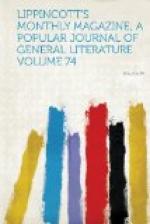The theological world is no stranger to subtleties, but never perhaps did causes so trifling breed such interminable quarrels. The sign and the form of the cross, the heading of processions westward or eastward, the reading of a particular article of the Creed, the spelling of the name of Jesus, the inscription to be placed over the crucifix, the single or double repetition of the Hallelujah, the number of eucharistic wafers to be consecrated,—such are the leading points in the controversy which ever since has rent the Russian Church. The orthodox make the sign of the cross with three fingers, while the dissenters follow the Armenian practice of only two. The former permit the cross with four arms, like our own: the latter cannot away with any but that with eight arms, with a crosspiece for the Saviour’s head and another for his feet. Since the reform the Church chants the Hallelujah thrice, the Raskolniks only twice. The dissenters defend their persistence by symbolical interpretations, and delight to make a profession of faith out of the simplest rite. For instance, they insist that after their fashion of making the sign of the cross the three closed fingers render homage to the Trinity, while the two others testify to the double nature of Christ, so that, without uttering a word, the sign of the cross is an act of adherence to the three fundamental dogmas of Christianity—the Trinity, the incarnation and the atonement. In like manner they interpret the double Hallelujah following the three Glorias, and cast it in the teeth of their opponents that they ignore in their ritual one or another of the great Christian doctrines. Such interpretations, based on corrupted texts or feigned visions, show the grotesque blending of coarseness and subtlety which makes up the Raskol.
If we may judge from the origin of the schism, its essence lies in the worship of the letter, the servile respect for forms. To the anti-reforming Russian, ceremonies form the whole of Christianity, and liturgy is one with orthodoxy. The same confusion between faith and the outward forms of worship is revealed by the chosen name in which the dissenters delight. Not content with the title of Starovbriadtsy (old ritualists), they adopt that of Starovery (maintainers of the old faith), which amounts to styling themselves true believers, the genuine orthodox,




